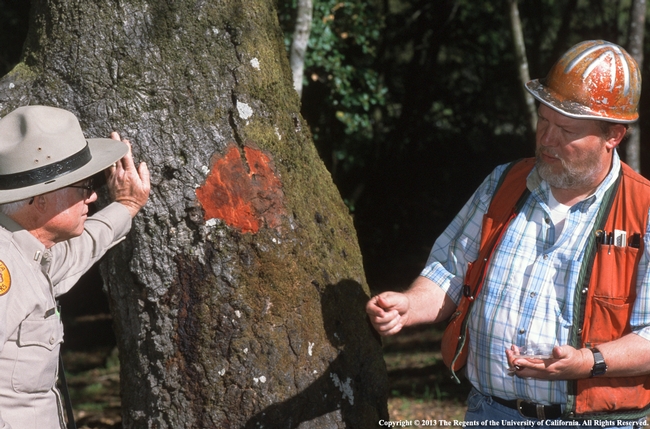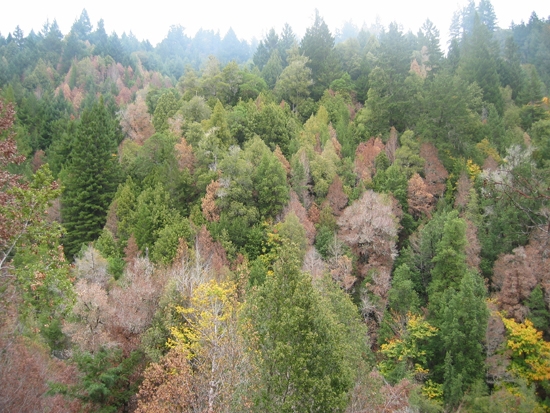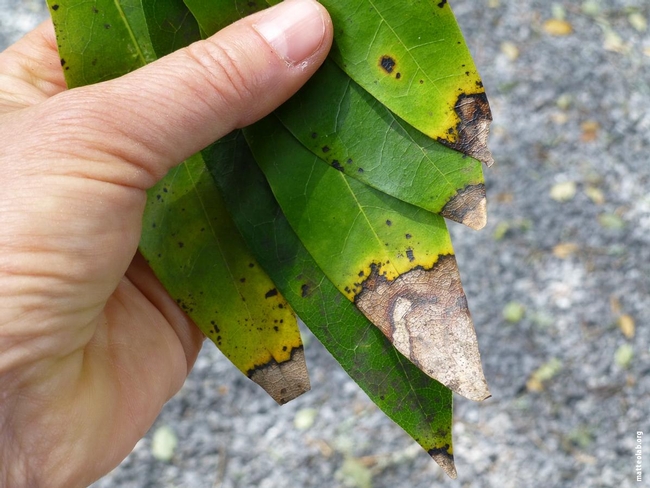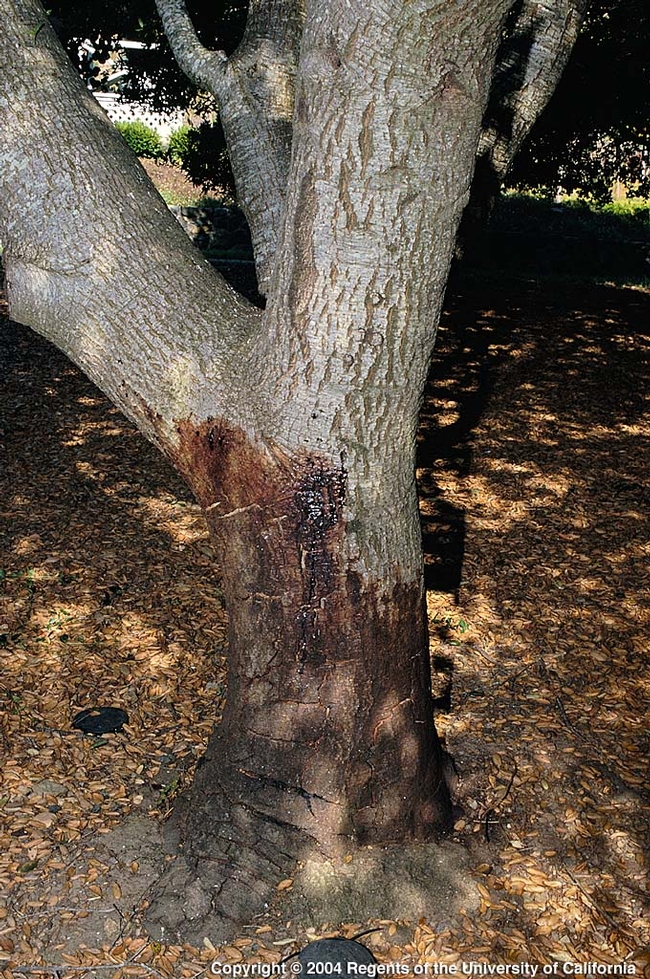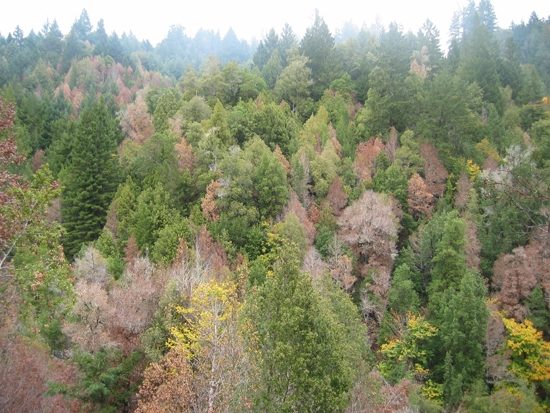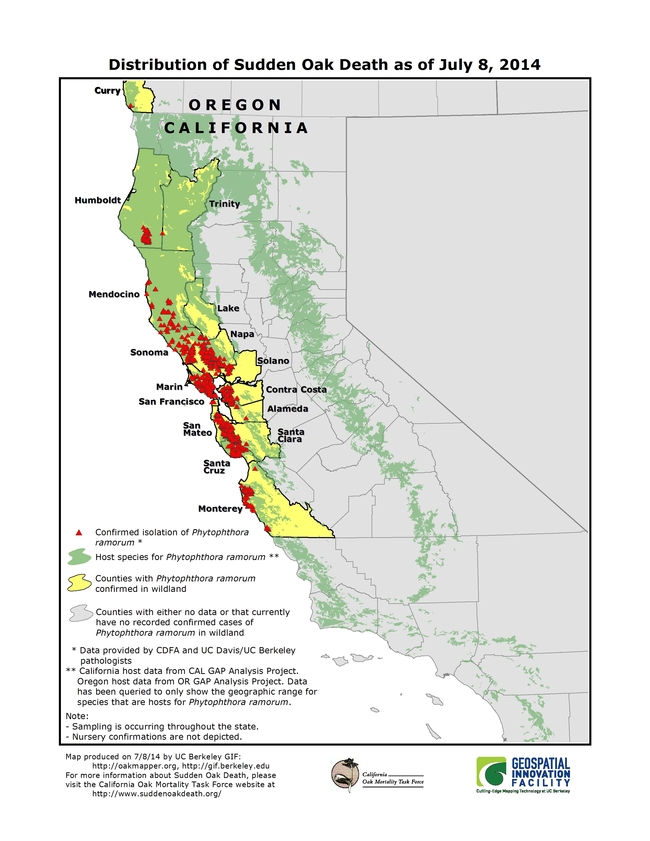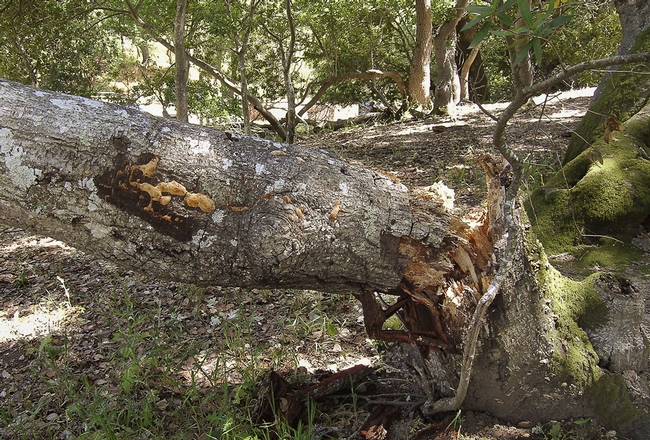Posts Tagged: Sudden Oak Death
2020 may see increased number of trees suffering 'sudden oak death'
California's unseasonably rainy spring may trigger more incidences of tree mortality due to sudden oak death, reported Sonia Waraich in the Eureka Times-Standard.
That impact may not be known for a while. UC Cooperative Extension forest advisor Yana Valachovic said the spike in tree deaths typically occurs the year following the spring rains, making 2020 a year of particular concern.
“One of the issues that becomes very apparent is that when we have these peak episodes of mortality, there isn't much funding to help us manage those impacts,” Valachovic said.
UCCE research associate Brendan Tweig said land managers must be flexible in implementing strategies to prevent the spread of sudden oak death.
"The disease doesn't go where you think it's going to go and then you're always limited by what you can do at any given location," he said.
The areas where the disease is discovered are treated more heavily, Twieg said.
The treatment strategy relies primarily on thinning infected trees, which increases air flow between the remaining trees. That helps dry out the area and avoid creating the moist environment in which the disease does best.
Sudden oak death bioblitz to help stem the spread of disease
UC Cooperative Extension is hosting a sudden oak death bioblitz April 25-28 in Northern California, in which a corps of volunteers will fan out across the wildland areas to track the progression of the devastating disease, reported Derek Moore in the Santa Rosa Press Democrat.
Sudden oak death is caused by the pathogen Phytophthora ramorum, which was inadvertently introduced to California forests on nursery stock in the 1990s. The disease has killed up to 50 million trees (primarily tanoak, coast live oak, California black oak, Shreve's oak and canyon live oak) from Big Sur to southwest Oregon.
Kerry Winiger, the UCCE sudden oak death outreach coordinator, is organizing this weekend's bioblitz in Sonoma and Mendocino counties.
Wininger said one of the highlights of this year's surveys is the unveiling of a new test for the European strain of Phytophthora ramorum in time to possibly thwart its spread. The new strain has been detected in Oregon.
“We want to nip it in the bud, if it's here,” Wininger said.
Sonoma County is still reeling from deadly wildfires, making the spread of SOD infection seem to some like a lower priority.
But Winiger said that oaks, as a keystone species, are crucial to the overall health of an ecosystem.
“It's like an arch,” she said. “If you lose a stone in the arch, everything else in the ecosystem is affected.”
High interest in SOD spread to San Luis Obispo County
Central Coast residents, officials, ranchers and representatives of conservation organizations came out in force to a November UC Cooperative Extension meeting sounding an alarm about the recent detection of Sudden Oak Death (SOD) in San Luis Obispo County trees, reported Kathe Tanner in the San Luis Obispo Tribune.
This was the first such gathering in this county since tests confirmed that the disease made its way south of Monterey County, according to event coordinator Mary Bianchi, director of UC Cooperative Extension in SLO County. But there will be more meetings to come, she said.
Previously confirmed infestations of the disease stayed north of the Monterey County border with San Luis Obispo County. Because SOD spreads by wind and rain, experts believe the prolonged California drought inhibited the spread further south. However, recent tests confirmed the SOD pathogen, phytophthora ramorum, on oaks along the parking lot at Salmon Creek, and in bay laurel trees along Santa Rosa Creek Road, west of Atascadero near Highway 41 and along Stenner Creek and Prefumo Canyon in San Luis Obispo.
Another intensive survey to be conducted by foresters and volunteer citizen scientists in the spring will include Cambria neighborhoods, ranches and other areas. In the meantime, residents were asked to keep an eye out for SOD symptoms in local bay laurel and oak trees. SOD lesions show up as pixilated brown, black or gray areas on leaf tips. Oozing cankers on an oak tree, with sap coming out of the trunk but with no wound evident on the bark, is another sign that the trees could be infected with the pathogen that causes SOD.
Sudden oak death still a threat and still spreading
Thirteen years after sudden oak death was first detected in California, the disease's range in northern coastal areas of California and southwest Oregon continues to grow, according to a report by Michael Joyce on Jefferson Public Radio.
Joyce interviewed Yana Valachovic, a forest advisor for UC Agriculture and Natural Resources in Humboldt and Del Norte counties. Valachovic is also director of the UC ANR Cooperative Extension offices in Humboldt and Del Norte.
"For me, the challenge is communicating to the public the disease has not gone away; in fact, it's actually getting substantially worse," Valachovic said.
Sudden oak death is caused by the pathogen Phytophthora ramorum. Currently less than 2 percent of Humboldt County's 2.25 million acres of forest are impacted by sudden oak death. But the average annual rate of expansion per year is 3,500 acres, Valachovic said. One challenge related to containing the disease is the structure of California forest agencies.
"The wildlands of California don't have a single agency that's responsible for controlling invasive introductions," she said. "Secondarily, there is no funding source that is set aside to manage these kind of epidemics. And so everything is piecemealed together: piecemealed responsibility, piecemealed in funding to address these issues."
Furthermore, Forest Service funds can only be used for monitoring, containment and education.
Joyce concluded the story with a question: "How will we learn more about this disease that is spreading through our forests at a clip of about 5 miles per year?"
Read more about sudden oak death on the California Oak Mortality Task Force website.
Drought is slowing the spread of sudden oak death
Finally, some good news about the drought. Dry conditions have apparently curbed the spread of sudden oak death in 12 coastal California counties, reported Guy Kovner in the Santa Rosa Press Democrat.
"If we had one more year of drought, it would really be ideal," said Matteo Garbelotto, UC Cooperative Extension specialist in the Department of Environmental Science, Policy and Management at UC Berkeley.
The article said Garbelotto isn't hoping for more drought, but evidence shows that the drought is helping reduce SOD infection rates and in some cases is curing infected trees, "because the pathogen dies."
Each spring, the UC Berkeley SOD lab hosts a "blitz" to gauge the spread of Sudden Oak Death. Volunteers fan out across areas susceptible to SOD and collect leaf samples for analysis.
In the Cloverdale area, where an outbreak was confirmed last year, none of the trees sampled had the disease this year, the article reported.
"I would say it is there, but we just didn't find it," Garbelotto said.
East of Highway 101, the rate dropped from 26 percent infected last year to 23.3 percent in 2014, the story said.
Complete SOD blitz results will be available Sept. 29 on the UC Berkeley Forest Pathology and Mycology Lab website.

